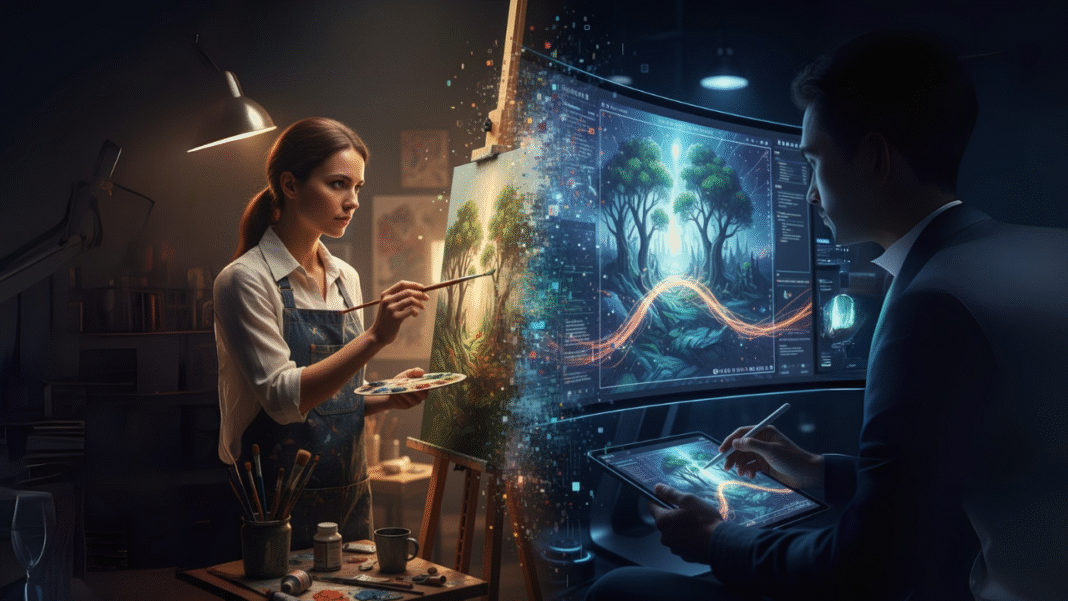This painting sold for $432,500 at auction in 2018… but it wasn’t created by a human artist. 🎨 “Edmond de Belamy,” generated by an AI algorithm, sparked a global debate that continues today: Can machines truly be creative, or are they sophisticated mimics?
The question touches the heart of what makes us human. Creativity has long been considered our unique domain – the realm of emotion, inspiration, and genuine artistic vision. Yet AI is now composing symphonies, writing poetry, designing fashion, and creating visual art that moves people to tears.
Today, we’ll explore this fascinating intersection of technology and creativity, examining whether AI represents a threat to human artists or an unprecedented opportunity for collaboration. You’ll discover 10 powerful AI creative tools that are revolutionizing artistic expression and learn how the smartest creators are already leveraging these technologies to amplify their creative potential.
Understanding AI Creativity
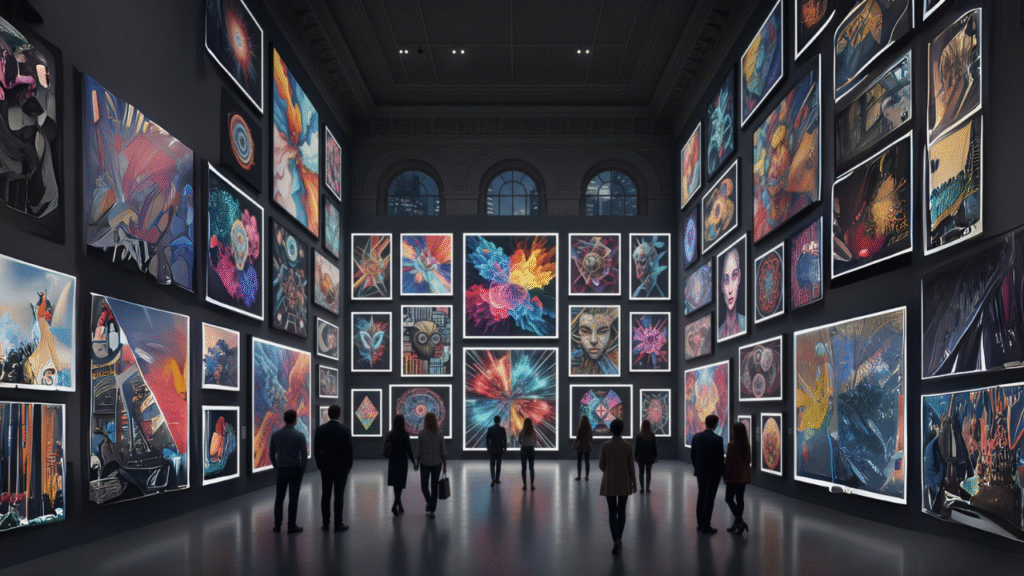
What Makes Creativity “Creative”?
Human creativity springs from lived experience, emotional depth, cultural context, and intentional expression. When Picasso painted “Guernica,” he channeled his horror at war’s devastation. When Rahman composes a melody, he draws from decades of musical tradition and personal experience.
AI creativity operates differently. Machine learning algorithms analyze millions of existing artworks, identifying patterns, styles, and techniques. They don’t “feel” inspiration – they recognize statistical relationships between colors, shapes, musical notes, or words, then generate new combinations based on learned patterns.
Groundbreaking AI Creative Milestones:
The AI creativity revolution began accelerating in 2018 with “Edmond de Belamy,” but it’s exploded since then. AIVA (Artificial Intelligence Virtual Artist) has composed over 30,000 musical pieces, some indistinguishable from human-created classical music. OpenAI’s Jukebox generates music with lyrics in various styles, while GPT models write poetry that wins literary contests.
The Collaboration Model Reality
Here’s the key insight: AI doesn’t replace human creativity – it amplifies it. The most successful AI-generated art involves human curation, direction, and emotional input. AI provides infinite variations and possibilities; humans provide purpose, meaning, and emotional resonance.
AI Art & Design Tools Showcase
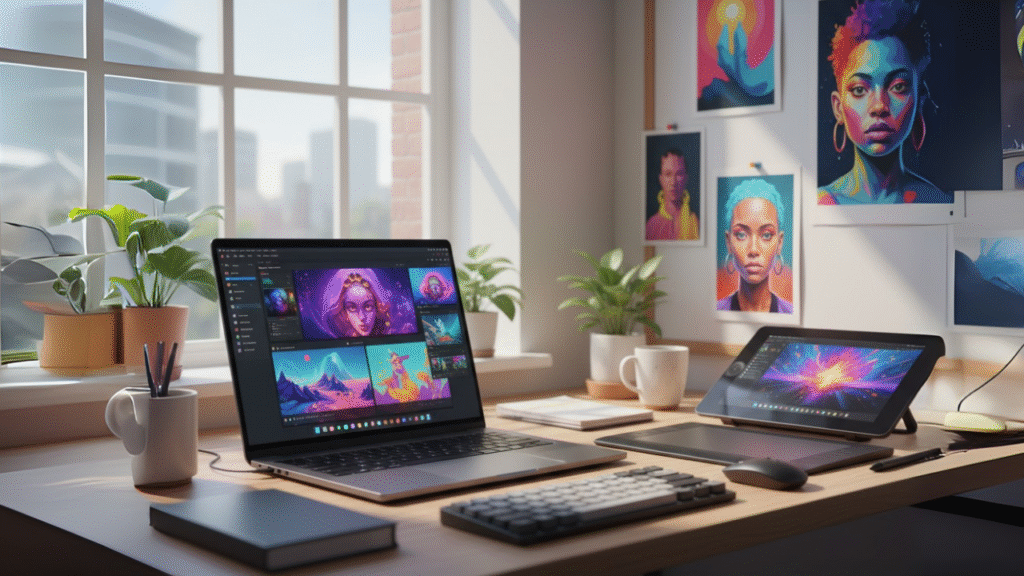
Image Generation Powerhouses
DALL-E 3 revolutionizes visual creation with unprecedented prompt understanding. Request “a Mumbai street scene in Van Gogh’s style during monsoon season,” and receive photorealistic results that perfectly blend artistic vision with specific cultural context.
Midjourney excels at artistic interpretation and style mastery. Its community features allow artists to learn from each other’s prompts, creating a collaborative ecosystem where creativity compounds. Professional illustrators use Midjourney for concept art, saving weeks of initial sketching.
Stable Diffusion offers open-source flexibility, allowing complete customization. Artists can train models on their own work, creating AI assistants that understand their unique style and vision.
Adobe Firefly addresses commercial concerns with training data sourced only from licensed content, making it safe for professional use without copyright worries.
Design & Graphics Revolution
Canva AI Magic Studio transforms anyone into a graphic designer. Simply describe your vision: “Professional LinkedIn banner for data scientist” generates multiple options instantly, complete with appropriate typography and color schemes.
Figma AI assists UI/UX designers with automated prototyping, intelligent layout suggestions, and design system optimization. What once took hours now happens in minutes.
Looka creates complete brand identities from simple business descriptions, generating logos, color palettes, and brand guidelines that rival human designers’ work.
Music & Audio Innovation
AIVA composes original classical and cinematic music for films, games, and commercials. Composers use it for inspiration and rapid prototyping before adding human emotional nuance.
Mubert generates infinite, royalty-free music streams adapted to specific moods, activities, or brand requirements – perfect for content creators needing background music.
Descript offers AI voice cloning and audio editing so sophisticated it can generate speech in anyone’s voice or remove “ums” and awkward pauses automatically.
Real Creative Collaborations
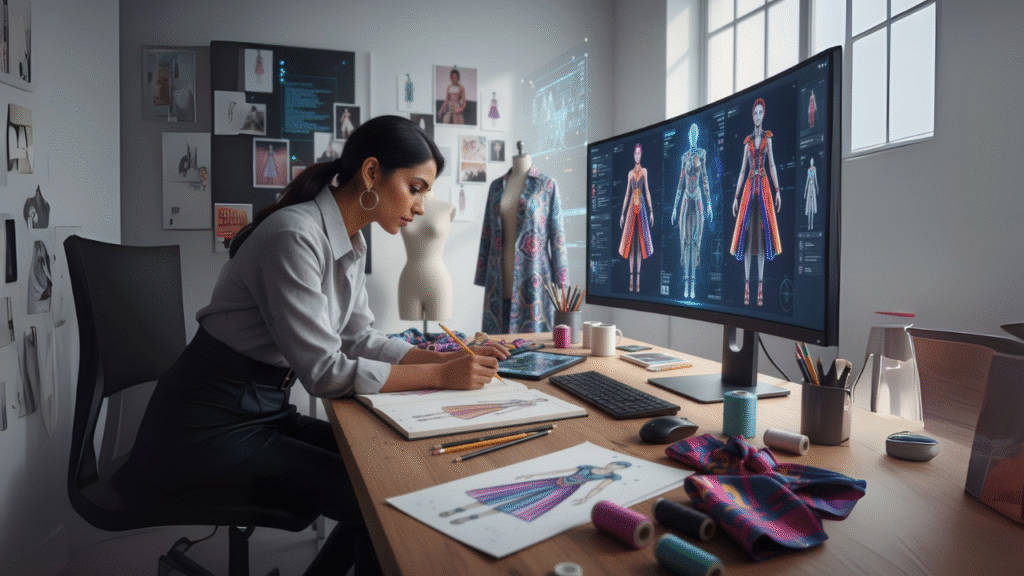
Success Stories Across Industries
Fashion designers are using AI to create entirely new textile patterns inspired by nature, architecture, or cultural motifs. Luxury brand Balenciaga collaborated with AI to generate fresh interpretations of classic designs, resulting in collections that honor tradition while pushing creative boundaries.
In architecture, AI helps designers visualize impossible structures and optimize building efficiency. Zaha Hadid Architects uses AI to generate complex geometries that would take months to design manually.
Indian Creative Renaissance
Mumbai-based artist Harshit Agrawal uses AI to preserve and reimagine traditional Indian art forms, feeding historical paintings into AI systems to generate contemporary interpretations that bridge cultural heritage with modern expression.
Bollywood composer Vishal Dadlani experimented with AI-generated background scores, using machine learning to create atmospheric music that responds dynamically to scene emotions.
Fashion brand Nicobar launched an AI-designed sustainable clothing line, where algorithms optimized fabric usage while generating patterns inspired by Indian textiles, reducing waste by 40% while creating stunning new designs.
The Creative Process Revolution
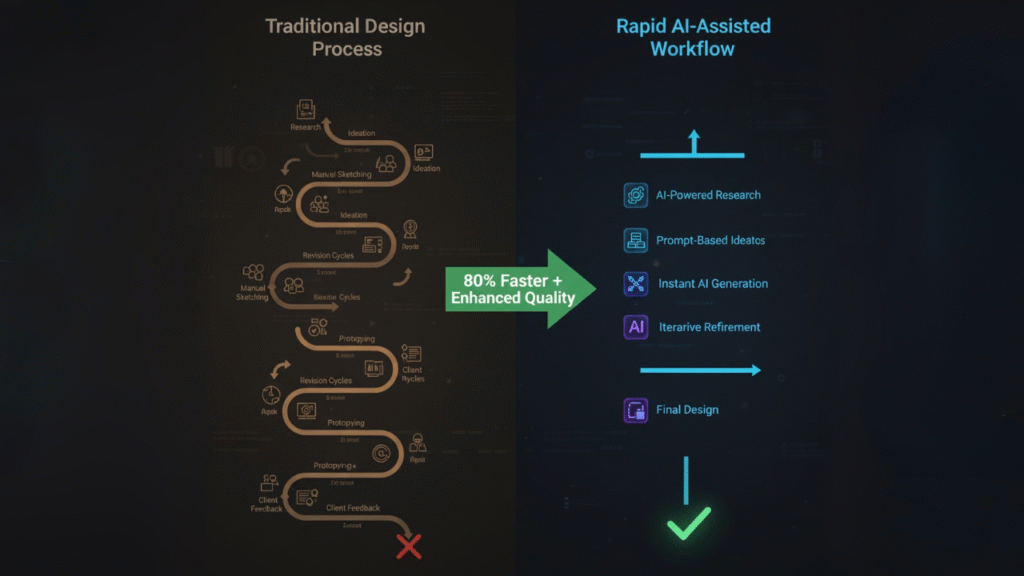
Speed Transformation: Traditional logo design might take weeks of sketching, client feedback, and revisions. With AI tools, designers generate hundreds of variations in hours, then focus human creativity on refinement and emotional resonance.
Iteration Explosion: AI enables rapid experimentation. Photographers can try thousands of color combinations, artists can explore infinite style variations, and musicians can test countless melodic progressions before committing to final versions.
Breaking Creative Blocks: When inspiration fails, AI provides infinite starting points. A writer struggling with character development can generate personality traits, backstories, and dialogue examples, then select and humanize the most compelling options.
Accessibility Revolution: AI democratizes creativity. Someone without formal training can now create professional-quality graphics, compose music, or write compelling content, leveling the creative playing field.
Ethical Considerations
The creativity boom raises important questions. Whose work trained these AI systems? How do we ensure fair compensation for artists whose creativity enables AI training? These discussions shape the future of AI-human creative collaboration.
Getting Started with AI Creativity
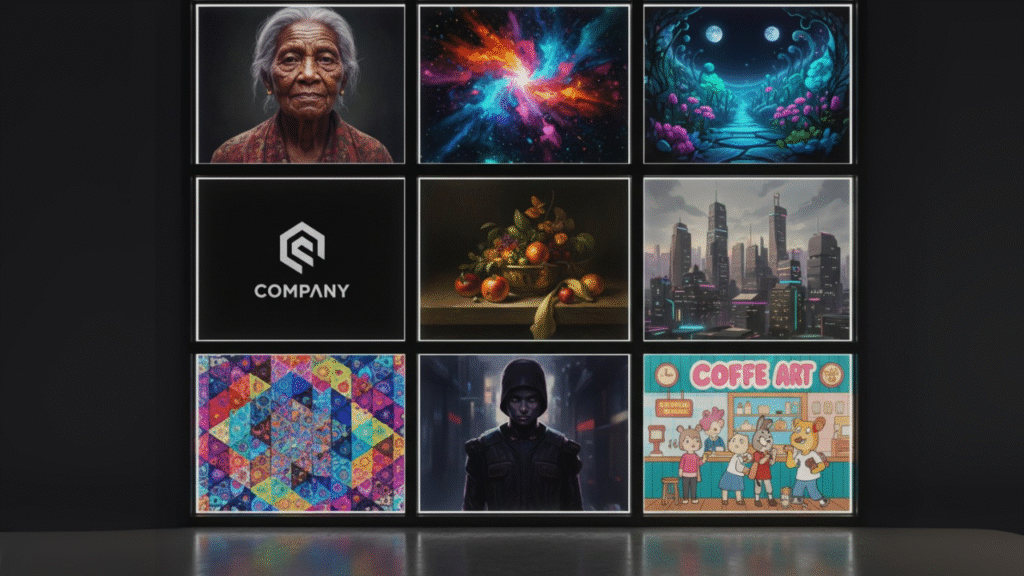
Your Creative AI Toolkit
Start with free tools like DALL-E 2’s limited credits, Canva’s AI features, or Stable Diffusion through online interfaces. These require no installation and provide immediate creative experimentation.
Best Practices for Success:
Master prompt engineering – be specific, descriptive, and iterative. Instead of “make a logo,” try “minimalist tech startup logo featuring geometric shapes, blue and white color scheme, conveying innovation and trust.”
Combine AI output with human touch. Use AI for initial concepts, then apply your artistic judgment, emotional intelligence, and cultural understanding to create truly meaningful work.
Try This Now: Generate three different mood boards for your next project using AI image generators, then select elements that resonate with your creative vision.
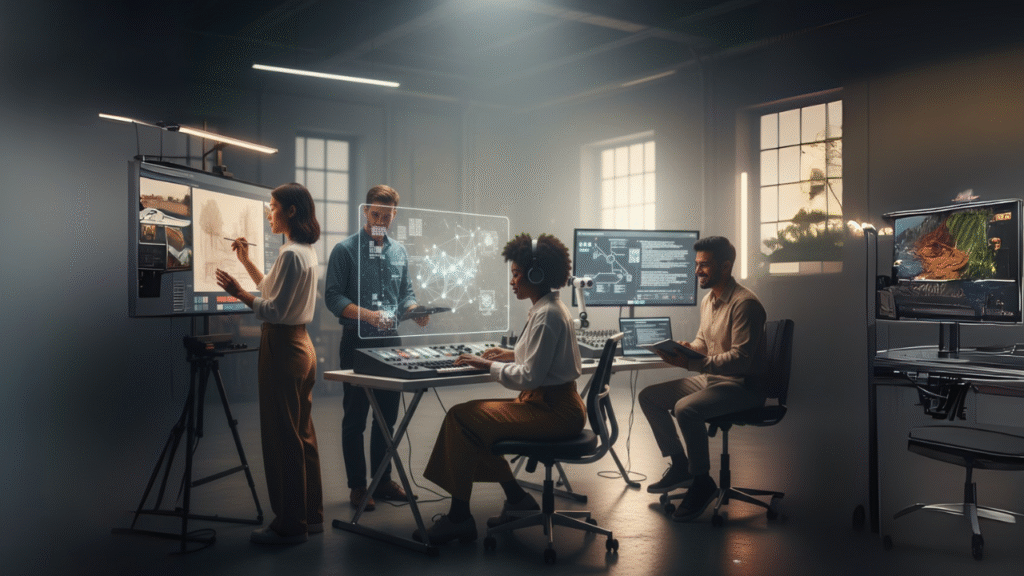
The Future is Creative Collaboration
AI isn’t replacing human creativity – it’s amplifying it in unprecedented ways. The most successful creators today aren’t fighting AI; they’re learning to dance with it, using machine intelligence to explore creative territories impossible to reach alone.
The key insight? AI handles the mechanical aspects of creativity – generating variations, optimizing techniques, and providing infinite inspiration – while humans provide the soul: emotional depth, cultural meaning, and intentional expression that transforms technical capability into genuine art.
Your creative journey with AI doesn’t require abandoning your artistic identity. Instead, it’s about expanding your creative toolkit with technologies that can make your unique vision more powerful, accessible, and impactful than ever before.
Ready to explore your creative potential with AI? Try our ‘7-Day AI Art Challenge’ with daily prompts and tutorials designed to unlock your creative collaboration skills!
What’s your take on AI creativity? Share your AI-created artwork or thoughts in the comments below – we’d love to see how you’re blending human creativity with artificial intelligence!
Next week: “The Future of Robotics: 5 Robots That Will Change Indian Industries Forever” – discover how physical AI is transforming manufacturing, healthcare, and service industries.
